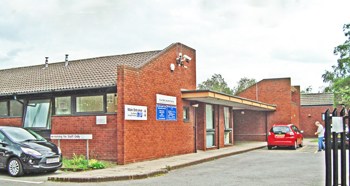Becontree Health Centre
Five Elms Road, Dagenham, Essex RM9 5TT
Medical dates:
Medical character:
Out-Patients only
In 1921 the LCC began to build the 300-acre Becontree Estate at Dagenham which would provide housing for working class families from the East End of London. It was the largest such housing project to be built in the world at the time, and would eventually contain some 25,048 dwellings, varying from 2-room apartments to 6-room houses. However, it did not seem to be the Council's policy to make Becontree a self-contained town with its own industries and amenities, but rather a dormitory suburb for London workers.
When King George V and Queen Mary visited the Estate in 1923, the Queen expressed concern that no hospital accommodation had been provided for an eventual population of 112,000 and, consequently, a fund was inaugurated to establish a voluntary hospital for the area.
Finding a suitable site, however, proved elusive and it was finally decided to extend the nearby Ilford Emergency Hospital, while an Out-Patients Department, to be administered and staffed by the Hospital, would be built in Becontree.
A site on Five Elms Road was leased to the Hospital Committee by the LCC for 999 years. The LCC also contributed £6,500 towards the cost of the building and an additional £15,000 towards the capital costs of the Hospital. Thereby, applicants from the Estate who needed in-patient treatment would be given special consideration.
The Becontree Health Centre and Out-Patients Department opened on 3rd January 1931. Its waiting hall could seat 200 people. The Centre also housed various municipal health services, such as maternity and infant welfare clinics, TB clinics and school clinics, which were run by Essex County Council and Dagenham Urban District Council. It had a small operating theatre and a casualty department for patients who said they had no doctor and whose incomes did not exceed £3 a week.
During the mornings the Centre was staffed by a Sister and two nurses, all of whom were resident. In the afternoons, including Sundays, a Medical Officer was in attendance, seconded from the Ilford Emergency Hospital. Other staff from the Hospital, such as masseurs, attended daily as needed. Patients were treated with dressings, massage (physiotherapy) and lotions, but no medicines were prescribed. Patients could be referred for treatment at the Hospital, but no medications were prescribed there either.
By 1934, when the population was estimated to be 118,000, some 8,283 patients had made 49,401 attendances. Essex County Council had made arrangements with the Centre for children to be referred by its school clinics for removal of tonsils and adenoids. A ward of 10 cots was set up and some 298 such operations were carried out during 1934. By this time, a Sister and three nurses were in residence, with the Hospital still providing medical staff.
By the early 1960s the Centre had become a Chest Clinic.
In 1974 the Centre was rebuilt and renamed the Five Elms Centre. The arrangement with King George Hospital, Ilford, came to an end as the new Centre contained GP surgeries.
During the 1990s the Centre came under the control of Barking and Dagenham Primary Care Trust.
Present status (June 2011)
The Five Elms Health Centre today contains a variety of services, including the Five Elms Medical Practice. It is under the control of the Barking and Dagenham Community Health Services, part of the North East London NHS Foundation Trust.

The Five Elms Health Centre (above and below).

www.british-history.ac.uk
(Author unstated) 1923 Nursing echoes. British Journal of Nursing, 30th June, 409.
(Author unstated) 1930 Proposed health centre at Becontree. British Medical Journal 1 (3608), 412.
(Author unstated) 1934 Problems of Becontree. British Medical Journal 2 (3860), 1207.
(Author unstated) 1935 Health Centre of Becontree Housing Estate. British Medical Journal 2 (3889), 131.
(Author unstated) 1936 Co-ordinated town planning. British Medical Journal 1 (3921), 432.
Thomas EW Caryl 1932 Problems in public health encountered in a new area. Proceedings of the Royal Society of Medicine 26, 207-216.
Return to home page